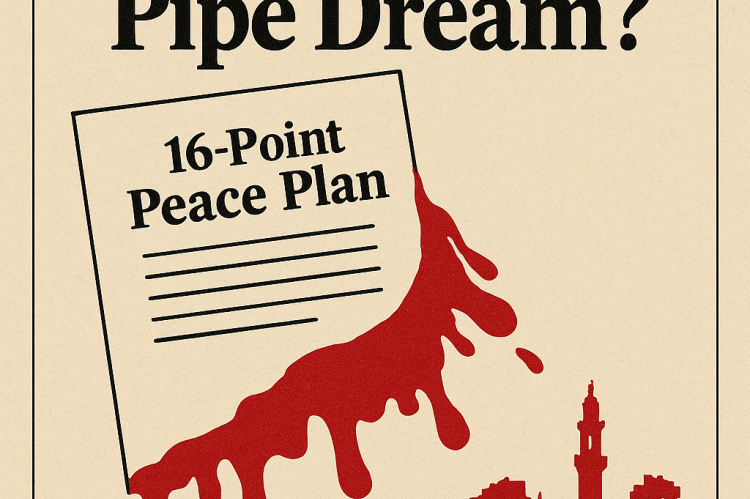A Pipe Dream for Control, Not Peace: Why the U.S. 16-Point Plan Fails Palestine
The So-called Peace Plan: not designed to end the conflict but re-engineered to keep Palestine under permanent control.
By: Omar Silva I Editor/Publisher
National Perspective Belize I Digital 2025
Belize City: Wednesday 1st October 2025: The United States’ much-touted “16-point peace plan” for Gaza and the Palestinian future has been hailed in Western capitals as a roadmap to end the war. But beneath the layers of diplomatic phrasing lies a plan riddled with holes, traps, and built-in asymmetries that all tilt in Israel’s favour. Far from laying the foundation for a sovereign Palestinian state, it recycles old formulas of control under new packaging, ensuring that Israel’s grip remains intact while Palestinians are stripped of both agency and defence.
What the Plan Actually Says
The 16-point outline calls for an immediate cessation of hostilities, the release of Israeli hostages within 72 hours, and a staggered release of Palestinian detainees. It demands Hamas’ total disarmament and the dismantling of all tunnels and military infrastructure. In the interim, Gaza would be governed by a so-called “technocratic” Palestinian committee overseen by a U.S.-led Board of Peace and international stabilization force. Israel, for its part, would withdraw “in stages,” only after security benchmarks are met.
Statehood for Palestine is not promised but merely presented as a “future aspiration,” contingent on reforms of the Palestinian Authority, redevelopment, and unspecified compliance with international demands. In short: no guarantees, no timeline, and no binding recognition of a Palestinian nation.
Point by Point: A Rebuttal
1. No Seat at the Table for Hamas
The plan was drafted without Hamas — the de facto governing force in Gaza. Excluding Hamas from negotiation delegitimizes the process and ensures no real buy-in from those who must implement any ceasefire on the ground. A peace deal without all parties involved is no deal at all — it is a diktat.
2. A Vague and Conditional Path to Statehood
The plan reduces the Palestinian dream of statehood to a distant, conditional aspiration. By tying sovereignty to indefinite “reforms” and vague “benchmarks,” it takes Palestinians back to square one — a cycle of dependency, promises, and delays. This is not a roadmap to independence; it is a trustee-ism meant to pacify world opinion while avoiding any binding recognition of Palestine’s rights.
3. Withdrawal on Israel’s Terms
Israel is not asked to end occupation unconditionally. Instead, it is given full discretion to “withdraw in stages” when it deems conditions safe. This amounts to granting Israel veto power over Palestinian sovereignty. At any moment, Tel Aviv can delay or suspend withdrawal, citing “security concerns.” In effect, the occupier decides when — and if — it will stop occupying.
4. No Independent Guarantors
The plan lacks any robust international guarantees. The U.S. and Israel retain oversight, with Palestinians forced to accept a U.S.-chaired “Board of Peace” as ultimate arbiter. There is no mechanism for Arab states, the UN, or neutral powers to enforce Israeli compliance. Without genuine guarantors, Israel is free to resume military campaigns under the pretext of security — and the cycle of bloodshed will continue.
5. The Trap of Total Disarmament
The demand for Hamas’ full disarmament before meaningful statehood guarantees strips Palestinians of any defence while leaving Israel armed to the teeth. In practice, this hands Israel a blank check to strike whenever it pleases, against a defenceless population. The so-called peace plan cuts off the head of Palestinian resistance but leaves the viper of Israeli militarism intact.
6. Palestinians Reduced to Passive Subjects
By placing governance in the hands of technocrats under foreign oversight, the plan denies Palestinians the right to chart their own course. It undermines national identity, self-determination, and the dignity of a people who have fought for decades for recognition. Palestine is reduced to an administrative project, not a sovereign state.
The Bigger Picture: Peace as Control
The so-called peace plan is not designed to end the conflict but to re-engineer it under permanent control. It creates the optics of diplomacy for Washington and Tel Aviv, while shackling Palestinians to a conditional process that may never deliver freedom. This is not peace, but pacification.
The contradictions are glaring: the plan demands total capitulation from Palestinians while granting Israel flexibility, discretion, and military superiority. The occupier is made judge and jury; the occupied are treated as wards of an international trusteeship.
The True Road to Peace
Belize and the global South must call this plan what it is: a diplomatic fig leaf for permanent occupation. Real peace requires a Palestinian state with recognized sovereignty, territorial integrity, and national dignity, not an indefinite “aspiration.”
Such a state must be guaranteed by Arab nations, the United Nations, and the wider international community — not overseen by Israel’s allies and apologists. Palestine must be free to govern itself, defend itself, and shape its own future.
No genuine peace can emerge while Israel is allowed to act as an armed watchdog over Palestinian lands, with one hand on the trigger and the other signing conditional promises.
Our Stand
At National Perspective Belize, we stand firmly on the side of a true and sovereign Palestinian state. The world owes Palestinians not another pipe dream of conditional sovereignty, but the recognition of their rights as a people.
The time has come for a Free Palestine — ruled and governed by Palestinians, for the future of its people. Nothing less honours their sacrifice, and nothing less will bring lasting peace.
- Log in to post comments

